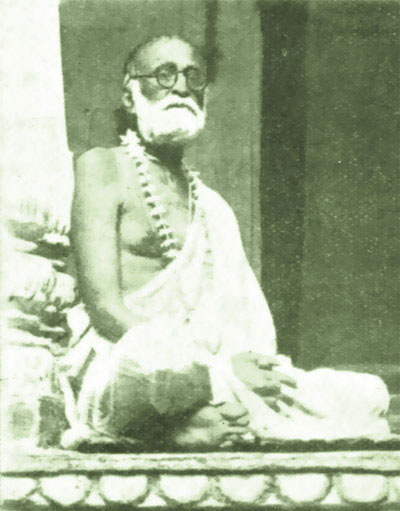śrī śrī guru gaurāṅga jayataḥ!

Year 9, Issue 8
Posted: 21 September 2016
Dedicated to
nitya-līlā praviṣṭa oṁ viṣṇupāda
Śrī Śrīmad Bhakti Prajñāna Keśava Gosvāmī Mahārāja
Inspired by and under the guidance of
nitya-līlā praviṣṭa oṁ viṣṇupāda
Śrī Śrīmad Bhaktivedānta Nārāyaṇa Gosvāmī Mahārāja
Religious Views - Part Two
by Śrīla Bhaktisiddhānta Sarasvatī Ṭhākura Prabhupāda

...Continued from Religious Views - Part I
Śrī Śankara was the ācārya (preceptor who teaches by example) of the doctrine stating that reality is comprised of undifferentiated consciousness (cit-nirviśeṣa vāda). By adopting the pañcopāsanā system, in which five specific demigods are worshipped, he has affected a compromise between religious merit (dharma), worldly prosperity (artha), sensual gratification (kāma) and emancipation (mokṣa).
Within the pāñcarātra (a system inculcating five types of knowledge), in the work called Puruṣa Saṁhitā, it is set forth that man worships Sūrya (the sun god) to obtain religious merit, Gaṇeśa for worldly prosperity, Śakti (nature, energy, or yin) for sensuous gratification, and Śiva, also known by the name Rudra, for emancipation.
In Śrī Śankara’s school of thought, when one worships these entities, believing that they are factually impermanent (anitya) and unreal (acit), and subsequently attains perfection (siddhi) in their worship, the specificity between the worshipped and the worshipper disappears. With this realization of unity (advaita-siddhi) or the ‘undifferentiated state’ (nirviśeṣa), one gains the ultimate object of one’s desire.
For this reason, worship of Viṣṇu that is motivated by selfish desire is also classified as pañcopāsanā, or ‘worship of the five’. (For example, it is prescribed in śāstra that one who desires the cessation of disease, sorrow and fear should worship the form of Viṣṇu called Dadhivāmana.) In such Viṣṇu worship, the worshipper also aspires to dissolve the object of worship and completely merge the individual self with the infinite, undifferentiated Brahman.
Therefore, we see that pañcopāsanā, being based on these doctrines, cannot, by any means, be considered the highest (parama), eternal (śāśvata), permanent (sanātana) or constant (nitya) purpose (dharma) of the living being (jīva).
Hence, the Śrīmad-Bhāgavatam states:
sa vai puṁsāṁ paro dharmo
yato bhaktir adhokṣaje
ahaituky apratihatā
yayātmā suprasīdati
Śrīmad-Bhāgavatam (1.2.6)
Humankind’s highest purpose is to attain unconditional and unending bhakti for the Transcendent Source, which is the perfect fulfilment of self.
In other words, the means by which bhakti (devotional faith) in Adhokṣaja (the Transcendent Source, or Godhead) is aroused, is the highest dharma of humankind. Such devotional faith possesses two distinguishing features: (1) it is ahaituki (causeless) and (2) it is apratihata (uninterrupted). It is only by such devotional faith that the self can be completely satisfied.
The word adhoksaja used in this passage means ‘He who transcends the knowledge born of the senses’. “Adhah kṛtam atikrāntam akṣajam indriyajaṁ jñānaṁ yona saḥ – He who exists beyond the scope of all the jīva’s sense-born knowledge.”
He is Śrī Kṛṣṇa.
He is entitled to enjoy His own existence in ways that transcend the reach of the sense-born knowledge of horizontally moving entities such as animals, men and gods. That prītī (love) for this Transcendental Reality that is produced by practising the highest dharma is known as bhakti, and it is characterized by seva (devotional service – bhaja dhātuḥ sevāyām) that is untainted by the pursuit of any personal advantage and that is ever uninterrupted.
Worship of some object enacted by those who desire religious merit, worldly prosperity, sensuous gratification or emancipation, is not śuddha-bhakti (pure devotion). Moreover, the temporary excitation of bhakti resulting from peculiarities in place, time or object can be interrupted and distorted by the progress of time, and is therefore not pure devotion.
Devotion that is unconditional (ahaituki), or in other words, which is based on the desire for exclusive love for the transcendental object of worship, and which has no intermissions and cannot ever be interrupted, grants fulfilment of the self (ātmān). Here, the word ‘self’ does not merely mean the perishable body made up of the five elements (pañnca-bhautika), along with its ten sense organs; nor does it mean the mind (manas), the eleventh sense – the propeller, or ruler, of the aggregate of the sense organs. All effort by the jīva’s body or mind only gratifies his senses and is not love for the Transcendent. Service, or devotion, to the Transcendent is not actually gratification of the senses. Śrī Nārada Pañcarātra says,
sarvopādhi-vinirmuktaṁ
tat-paratvena nirmalam
hṛṣīkeṇa hṛṣīkeśa-
sevanaṁ bhaktir ucyate
Śrī Caitanya-caritāmṛta (Madhya-līlā 19.170)
The desire to love exclusively Viṣṇu, who is the Lord of the senses (Hṛṣīkeśa), using all of one’s senses, is called devotion. This devotion is not covered by the twin conditions of gross and subtle matter, and because the end awarded by this means is itself loving service to Viṣṇu, it is śuddha, or free of impurity. In the jīva’s state of bondage, there is a predominance of sense-born knowledge and aversion to serving Transcendence. Hence, the bound jīva’s spiritual self and her innate impulse to perform pure devotion have been covered over by those two conditions: gross and subtle.
Within the three realms (vyāhṛtis), from Earth (bhūr), to Atmosphere (bhuvaḥ) and to the Heavens (svār); within the four higher cosmic dimensions (lokas), Mahar, Janar, Tapar and Satya, which are situated above the three realms (vyāhṛtis); and in the seven infernal regions beginning with Ātāla; that which enjoys the senses as they chase sense-objects is not the self (ātmān) but an attribute thereof (upādhi); it is the non-self. This pursuit is not characteristic of following the Transcendent with surrender and devotion, rather it is merely temporary gratification of the senses. Such mental functioning will manufacture narrowness and sectarianism.
Adapted from The Gaudiya Volume 57
by the Rays of The Harmonist team